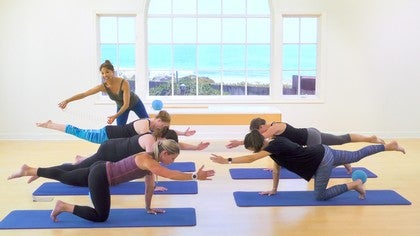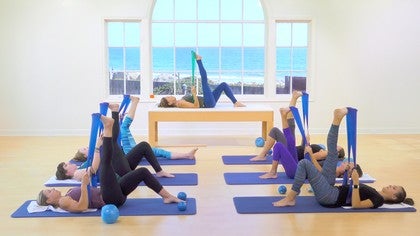Description
About This Video
Transcript
Read Full Transcript
Hi there. I'm Kathy Morikami. Welcome to this really exciting progression that I'm so excited to teach. Um, I love teaching the fundamentals to this technique because I believe that really understanding and feeling the fundamentals to the [inaudible] method is going to be the key to your success. So this progression series is divided into four sections. The plan is going to be that each section is about 40 to 45 minutes long and we will be giving you pieces along the way. So I kind of, um, make the metaphor that is playing dot two dot. Like a.to dot coloring book.
So when you're a little kid and you can play.to dot, or you draw on a.to.book, you get the page and there's a bunch of dots and you don't know what the picture is, but as you start to connect the dots, the picture starts to come into focus. So as we get into focus, you will start to really feel the methodology and the method to the madness and have a lot of fun along the way. All right, so ladies, we are going to start with understanding alignment Sunday standing alignment. So if you're at home and you're on carpet, you may feel a little more comfortable on the floor. So perhaps you ladies would like to be on the floor, these sponges or these Matt's a little bit spongy. Check your feet out, look down at your feet. We'd like you to point your toes relatively straight ahead and you have your leg bones in alignment with about the second toe.
So you feel where your hip bones are. Okay, go in medially, maybe about an inch to an inch and a half. And that is a straight line down to about the second toes. I see it goes through the middle of the knee cap or so. All right, so this Polonius is an alignment based methodology. I just want to make a quick explanation about the bony structure. From there. There's another straight line here.
This is going from the Chin through the clavicular notch right here where you'd love a beautiful diamond necklace to hang center, the sternum center, the pubic bone straight line down to in between both feet right in the mid point there. Okay. Then, uh, from the side, this one might be a little bit more challenging to see yourself cause you'd might have to look in a mirror, but there is a plum line from the ear lobe through this bone. You'll fear feel here at the side of the shoulder, the chromium process, straight line down through the side seam of your clothing side, seam of your pants down there, straight to about where your ankle bone is. All right? So that's an ideal, efficient, bony structure alignment. Okay, so the first place we're going to start is we're going to pick up this squishy ball and you want them under inflated. So we're going to split, stick the ball over here on the right side of the torso, okay? Against the ribs, right then. Then we'll take a hold of the right wrist, the left hand, and just kind of relax. All right. This is where I get into something called a I, n.
A I n. Attention intention, no tension. So your attention is on your breathing. Okay? So you just put your mind there on your breathing and then your intention is to feel your body expanding into the place where you feel the ball a little bit touching the ribs. And then as you exhale, you feel your body soften and surrender a little bit away from the ball where it's touching your ribs. So go ahead and do that a few times. The trick is to do this with the n no tension.
So attention on the breath, intention to feel the body moving against the prop, all of that with no tension. Yeah. And how's it going? We feel ourselves getting a little bigger into the ball and not, yes. Okay. Try the other side. You probably don't need the sticky on this one. Okay, so we're trying it on the other side. Same thing that your arms really super relaxed now. Same breath attention on breathing, intention to feel the body expand and contract without any tension at all.
And even though you do not have a prop on the other side, hopefully you're still sustaining some memories, some cellular memory there. And how is that Kinda the same? Yeah. So if you take the ball out, take the wall out and then just continue to breathe. Do you still feel the feeling? That's what we're going for. And even though you don't have something on the exterior, you feel that wave like action of breath on the interior.
So you're getting in touch with the inner body. Okay? Because this work really is about finding the connections inside before the outside has a lot of changes. Okay? Okay. Very good. Now the ball is going here, so not at the knees, not at the groin, halfway in between. Get the feet back about where you had them. Okay. Relax. Still feel the breath in the rib area.
Expand and kind of like you have gills there on the side of your body. And we're going to add in another dot. So I just gave you the dot of breathing laterally. Lateral ribcage breath. Okay. So what are we doing with the ball here so that you can't run away? No.
So that you have some awareness. Okay. Attention on the inner thighs. Okay. Attention on the inner thighs. So go ahead and breathe in. And this time as you exhale, imagining the very top of the leg is like an elevator door and it starts to shut. It starts to shut with the exhalation. Yeah. So go ahead and do that very gently. So on a scale of one to 10 you're pressing the top of the legs towards one another with about an effort of five or six.
Not a lot. Okay. And on the exhale, so now you are multitasking. You're breathing in, filling an expansion laterally on the exhalation. Just make it one long exhale, pulling the elevator doors towards each other a little bit. And I'd like you to see if you can keep your awareness on both. Can we feel both? Okay, so you've got a couple of dots connected. Yes. Great. We're going to add another.now, the deep abdominal muscle called the transverse abdominis.
You don't have to remember that name, but this muscle is pretty interesting. Many people think the abdominals just live here in the front, but it actually wraps all the way around to the back body, the back body. And so I'd like you to envision that like the lining of address. Okay, so it's the back of the front and the front of the back. Okay. But your attention is going mostly in this region between the navel and the pubic bone and between the two hip bones. All righty.
So go ahead, take your inhale again. Start the exhalation, make it longer and pulley. Elevator doors shut. And as you do that, oh, you feel as something, something going on down here. A little whole lot of something going on. Yeah. Is it staying around a five or six? That's what we want. Remembers.
Not a bell ringer. Okay. Because it's subtle at first. This is neuromuscular reconditioning. So again, attention on breathing, intention to connect those dots. One, two, three. Yeah. Kinda happening. All right. Remember if it seems super subtle, that's how it is initially. Okay. So why is it that the inner thigh elevator door connection helps you feel this lower abdominal area? Well, because they have a relationship.
They have a relationship with each other, but they're secret lovers. K, nobody knows. They're secretly talking through a third party. That third party is your pelvic floor. Okay. Your pelvic floor. Um, some people call it a pelvic trampoline or I. So initially if you are new to finding your pelvic floor is the sensation of finding the muscle that stops the flow of urine. Okay. Subtly, it's not a grip. Alrighty. So now we know what we're talking about.
Yes. Because you're on the honor system here. I can't check. All right. Okay. All right. All together. Breathe in, widen a little bit. Exhale, elevator doors, pelvic floor. And maybe that five, one, two, a six or that six went to a seven. Subtly, slightly increasing.
The a I n attention intention. No tension. Yeah. Okay, good. Let's see if we can keep those dots. So let's take this ball now and we're going to place it here in your hand with your arms straight. All right. And then shrug that arm up and down a little bit. Oh, I don't have to turn around. And you can see here. Yes. So do you feel your shoulder blade moving up and down? Yeah. Okay.
Your shoulder blade is moving up and down because your arm is moving. So you may or may not know this, but this arm bone is actually connected to the scapula. So if one moves in general, the other needs to move fairly quickly. All right, we're going to call the attention now to this area right here, the lower tip of the shoulder blades. Okay? But you have the prop on one side, so your mind will feel that area more first.
What you'll do is a little bit present to the ball. Keep your hand relax, but open so you're not gripping. And then slide the ball down just a little bit and notice that little sensation you'll get right around here. Right around here. Okay, good. And try that again. Breathe in. Exhale, press in the ball. And slide down and then pretend you have went on the other side. Exhale are pressing in and slide down so you feel both sides.
But one has a prop and one does not cause this. Remember one day we have to take you off the bottle. There may be no props anymore. Alrighty, so we have the shoulder blade connection. Did you remember the elevator doors in the pelvic floor? Oops, maybe not. So let's try to remember that now. In fact, let's put the ball down.
K, I want you to still feel as though you have energy moving up your spine. So when you do this, sometimes what I see is there's so much work and oh, this kind of smushing down sensations. So there's still this sensation. It's like a magic show. It's a slinky. So the energy is still moving up the interior of the body while you have all this other activity going on. All right, so we're going to connect those dots that we've just been handed the dot of breathing, the dot of the inner thighs, the dot of the pelvic floor, the daughter feeling the abdominals. And now the dots of the shoulder blades still feeling that energetic lift that I showed you with the slinky of the spine, so we'll breathe in and then as we exhale, connect those dots gently so as though the balls were still under the hands reaching down, but the spine is still going up.
Ascending yet the outer body feels like it's descending. Yeah. Great. And remember the n no tension. Yes, no tension. Good. Very good. All right, so we're going to do a quick little partner thing, which is kind of cool. You do this at home.
I could have Haley up here on your back with your knees bent. Ladies, you can partner together, so on your back with your knees bent. Okay, so the way this is going to work so that you really can feel this in a supine position because is where you will tend to start a lot of the exercises we have that same alignment we talked about earlier and then what I'm going to do is this ball is going into the same place right here between the inner thighs. Then when I'm going to ask Haley to do is do the same breathing here. Inhaling, exhaling, just slightly sliding the shit scapula down, feeling the deep abdominals, closing the elevator doors.
And then what I'm going to do is I'm going to ask her on her exhale. I'm going to slightly pull, wait, wait. She's anticipating, did you see her knees squeezing? Because I want this action to happen without any bones moving, no structural change. It has to be a connection of the dots and the musculature. So what I'm going to do is I'm going to kind of slot, try to take the ball away from her, but I'm not pulling very hard just and I'm pulling in the direction of the thigh bone this way. So I'm not grabbing this way, I'm not grabbing this way.
Um, there is a conscious, like a dimmer switch kind of dim or switching on something like this and then dim or switching off. What I'm going to ask Haley to do is hang onto the ball with her elevator doors without seeing her thighs actually move. Hmm. So something like this, breathing in and then gently exhaling. And just a little bit. So again, scale of one to 10 around a five very slight. And she feels the inner thighs. Yes. With all your other dots. Yes.
See the answer is always yes. Then I'm going to ask her to hang onto the ball with her pelvic floor. Now technically is her pelvic floor hanging onto the ball? No. Right? No, but she's going to use this little bit of resistance to activate the pelvic floor in contrast. Contrast because you will, your body will learn a lot through the contrast of this gentle pull away. Yeah. So here we go. Will breathing in. Same thing. And she just uses that pelvic floor a little bit and there she Walla.
Slow down your breath. Exhale. Let me cue you. Yeah, good pause. And then inhale the inhale. We try not to let go of the pelvic floor. That's the challenge. And then I gently draw again. Something like that. Ladies, would you like to try?
I am pulling on the ball but I'm not. You can see I'm not yanking. It's really subtle because if I do this, she's going to squeeze the knees. And so when I personally like to talk about the inner thigh work, I don't cue because the mind goes distally far away. I want the work to stay closer in towards her center. So it's just a slight drawing like this.
Yeah. Okay. So we do, okay. So one of you is lying down. You can do it again and I'll cue you all through. So the ball is in place. Okay. The ball is in place and maybe you want to come on this side. All right. Take an inhalation. Okay. So Emma, maybe you want to be on this and you see how I'm facing? Yeah. Okay.
And when you're at home and you're doing this at home and you do not have someone to pull your ball, um, uh, you just have to imagine this or maybe you can ask someone close to you to do that for you. All right. You, the idea, it's, it's just a learning tool. All right, here we go. So we breathe in. As we exhale, very gently, teachers, you're drawing the ball in the direction of the knees and the students are finding the inner thighs in the pelvic floor. And then we slowly release, inhale and we do it again on the exhale. The intention is to bring awareness to the dots connecting together. And one more time. And ladies on the floor, are you finding this helpful? That was a yes.
I hope you saw that Chin nods. Good. Alrighty. Does that make any sense? Okay, very good. So for time sake, we're just gonna do one set right now for those of you on the floor and then we'll do something else later on where you'll switch your partners. Okay, thank you. Very good. Next piece, can we keep these dots connected in other positions? Can other positions? So this is what I call the Bisquick of Peloton. Okay. So most of you know what Bisquick is, right?
When you wish it up in the batter, in the pot or in the ball and you put it on the waffle iron, it becomes waffles. And then if you stir it up and maybe you add the eggs and something else, it becomes pancakes and then you stirred it up and you put it in the Muffin Tin. It becomes muffins, right? But it's still the same formula. So the formula here of these dots stays the same, but it feels different because we changed the position of the body in relationship to gravity. Right? Sometimes we use props so it feels like it's a completely different thing.
But the fundamentals stay the same. Okay, so this is what we're going to do. McKinsey or bird? Dog. So hands and knees position. We want to have this so the back of the head tends to drop to the floor a little bit. Can move your ponytail a little bit. I look away for just for one sec. So remember the plum line I talked about earlier. This, this alignment goes with you. Relax your neck and hip. Bring your head away from the floor. Yup.
Alignment goes with you wherever you are. The arms are straight up and down to the floor. So the thigh bones and the arm bones of perpendicular curl the back toes under everybody. Yes. Okay. Now I don't know what you had for lunch today, but I want you to let your lunch go. Let your lunch go. Do you know what I mean? Everybody always trying to suck it in around here in California, right in California. We got to suck it all in. So this is what you do.
You're going to just go ahead and that. Okay? Because this is a hollowed out here. Your guts. I want your guts to hang to the floor and gravity. And when you do that, you're going to feel your lumbar spine create a little bit of a curve. We want that. It's supposed to be there. Okay? Then can you do that same breathing we did earlier?
So you're going to breathe in to the side ribs a bit, and then as you exhale, find those dots. Inner thighs, pelvic floor, you feel the deep abdominal area and even the shoulder blades. Find a connection. Yes. So you're already working what's working? Just to hold this. Okay. Now we're going to challenge our ability to sustain this position. Ooh, I love to pull this ponytail. And then I want you to soften here just a little bit.
Inhale again without letting the abdominal wall completely go and very slowly on the exhale. Slide one leg back, but keep it on the floor, one leg back, but keep it on the floor so the toes remain on the floor and just stay there. Okay. And breathe the same way, the same breath. So now you feel a little more weight, probably on the arm of the side of the leg. You stretched back. Would that be yes, yes, of course. There you have less to uh, underneath the sport you feel. If you can connect those dots still and now further challenge.
Take another breath. Slide the opposite hand forward, but the fingers stay on the floor. The fingers stay on the floor. Good. Keep the dots connected. Stay in the center. You're getting distracted by the appendages, but try not to. Everybody's working hard right now. I'm going to lift your shoulder girl up on the next breath.
Levitate the arm and leg a little bit, maybe two, three, four, five, I don't know. Maybe parallel to the floor. Turn the thumb upward. And now let's breathe. Five breaths. Just like the beginning. Inhale side ribs. Pull the shoulder blade down. Exhale. Feel the deep abdominals. Inner thighs challenging to fill the inner thighs when they're not near each other. Keep breathing. Same breath, beautiful work.
And the sensation is this. The spine is still long. Energy is still through the arm and through the leg. Good. Who's counting somebody the official counter in this class. Hold lightly touch down and like a little airplane. Glide down the runway back to where you started.
And now if you need to give your wrist a shake or your bum, a little shake. I know you guys do. Go ahead. Okay, very good. So why do we just, you know, I know there's a lot of these exercises out there where you kind of move elbow to knee, up and down and everything, right? Okay. The reason I have you hold is because this core needs to build a marathon of strength, a marathon, a strength, not a sprint. Okay. So second side one, one more time. We do the same thing.
Now you may have noticed I did not say which arm or leg to stretch out. So these ladies did their favorite side first and so did you. Okay? And that's normal. That's totally normal. The second side sometimes is a little more challenging. Sometimes not sometimes a second side. Learn from the first side.
But let's see what happens. Okay, same. Go. Let the belly go. Take a breath. And then on the exhale just feel everything come to attention. Gently keep your connection, take another inhale. And then on the exhale you're going to slide the other leg, the one that you did not slide and reach it back. Okay, pause, take another little breath. And then, whoops, slide the opposite hand forward. Barely any weight on the fingertips. Lot of work in the center. Keep your mind focused. And on the next breath, go ahead and levitate. Go slowly.
So you'd like filling up with helium. Good. And here we go. With breathing in and out, one and in and out too.
Usually it's kind of harder than you think. Yes. So what we want to do is keep from head to tail and tax, shoulder girdle attack, pelvic girdle intact so that there's not a lot of getting ready to go out there. You really anchored from the inside, the inside and then you slide and then you slide and then it's a piece of cake and then you breathe, breathe, breathe, breathe, breathe, breathe, Dah, Dah, Dah, Dah. So there's not a kind of a reorganization, you already have to be there that it's like, um, it's like a hybrid car. I have a hybrid car and you turn the key and then it says ready, but you don't hear anything but it's ready. Do you see what I mean? So your body, your, but your, you're turned on but you're not in gear yet.
Something like that. Okay, good. Makes Sense. Alrighty. So we are going to go into a hinge right now to end this first segment. Um, may have, um, may have a volunteer up here. Okay. Becca on your knees. We're going to do something like that. Stretch. Okay. And she can curl her toes.
All right, so beck has got great alignment. Look at how strong she is. Here it is right there. Okay. And what I'd like to do is just challenge this a little bit. I'm going to allow her to have her arms forward just a little bit as a counterbalance, but she has to remember that her shoulder blades live on her back. Okay?
She's going to do the same organisational breath as she exhale. She connects, connects, connects, connects, connects. Then she's going to sustain that. She'll take another breath and from her knees, like if your knees had little wheels here, she's just going to hinge back in a straight line in just a little bit and come forward. Okay. Just like that again, she's exhaling. I would suggest you exhale when you first start this. Don't go too far. If you happen to have a prop, you could put that also between the inner thighs, just a little to see if you can connect the dots.
And sustain your alignment. That's it.
If you can't breathe, if you're wondering how many more are we going to do? Yes. If it's one of those two things, you've gone beyond going a little bit beyond your strength. Okay. Should we try? So thigh stretch. Very good. You can curl your toes under later on. If you want more challenge, you can keep the feet flat and you know what? Since you have the prop on it, use the balls in between the inner thighs.
Beautiful. Look at that. Are you sure you're all beginners? Exhaling back. Just hinge a little bit and forward. Let's just do three more. Exhaling back, not too far. Beautiful and forward and to go ahead.
Stretch your arms a little straighter. Yeah, like you really feel that energy coming at your fingers and up. Last one, everybody. Front, body, back, body pressing together and straight up. Beautiful. Very good. Okay. We're going to end right there.
Begin Pilates: Putting the Fun in Fundamentals
Comments
I just have a question concerning the pelving floor, that maybe you explained in the lesson, but I did not understand because of the language ;) (my English is not that good).
It is about squeezing the very top of the leg in oder to get a tension into the pelvic floor. This tension has to be not more than 5-6 .
Could you just explain me why I shouldn't squeeze as much as I can .
I ask because it is actually easier to squeeze there without thinking of keep the tension a bit more than half way. So I think important for me to know why.
Thanks so much for this lesson!!!!
Lisa
If you continue to practice at a 'lower' level of effort, it will become, eventually, quite significant in your awareness.
Please feel free to contact me personally via my website if you require more detail. Thank you for your inquiry andenjoythe progressions!

@Connie, PF work is always interesting to come up with new ideas for clients to connect with....glad it was helpful for you.
@Gladys, thanks for taking the time to comment and perhaps in the future, you CAN come and be a part of our class!

You need to be a subscriber to post a comment.
Please Log In or Create an Account to start your free trial.























